155148-31-5
| Name | AMD3100 octahydrochloride hydrate |
|---|---|
| Synonyms |
Bicyclam
Plerixafor 8HCl 1,4,8,11-Tetraazacyclotetradecane, 1,1'-[1,4-phenylenebis(methylene)]bis-, hydrochloride, hydrate (1:8:2) AMD 3100 octahydrochloride 1,1'-[1,4-Phenylenebis-(methylene)]-bis-(1,4,8,11-tetraazacyclotetradecane)octahydrochloride 1,1'-[1,4-Phenylenebis(methylene)]bis-1,4,8,11-tetraazacyclotetradecane octahydrochloride dihydrate 1,4,8,11-Tetraazacyclotetradecane (1,1'-[1,4-phenylenebis(methylene)]bis- Plerixafor Plerixafor octahydrochloride AMD3100 8HCl Plerixafor (octahydrochloride) |
| Description | Plerixafor octahydrochloride is a selective CXCR4 antagonist with an IC50 of 44 nM. |
|---|---|
| Related Catalog | |
| Target |
125I-CXCL12-CXCR4:44 nM (IC50) |
| In Vitro | The CXCR4 inhibitor Plerixafor (AMD3100) is a potent inhibitor of CXCL12-mediated chemotaxis (IC50, 5.7 nM) with a potency slightly better than its affinity for CXCR4. Treating the cells with CCX771 or CXCL11 has no effect on CXCL12-mediated MOLT-4 or U937 TEM. In contrast, 10 μM Plerixafor inhibits CXCL12-mediated TEM in both cells lines[1]. Plerixafor (10 μM)-treated cells show a moderate reduction in cell proliferation compared to CXCL12-stimulated cells, which do not reach statistical significance[2]. |
| In Vivo | Plerixafor (2 mg/kg) administration to UUO mice exacerbates renal interstitial T cell infiltration, resulting in increased production of the pro-inflammatory cytokines IL-6 and IFN-γ and decreased expression of the anti-inflammatory cytokine IL-10[3]. Both perivascular and interstitial fibrosis are significantly reduced by the CXCR4 antagonist, Plerixafor (AMD3100) at 8 weeks[4]. LD50, mouse, SC: 16.3 mg/kg; LD50, rat, SC: >50 mg/kg; LD50, mouse and rat, IV injection: 5.2 mg/kg. |
| Cell Assay | U87MG cells are seeded in 96-well plates at the density of 6×103 cells in 200 μL/well and treated with CXCL12, Plerixafor or with peptide R, as described in the previous “Treatments” section. MTT (5 μg/mL) is added at each time point (24, 48, 72 h) during the final 2 h of treatment. After removing cell medium, 100 μL DMSO are added and optical densities measured at 595 nm with a LT-4000MS Microplate Reader. Measurements are made in triplicates from three independent experiments[2]. |
| Animal Admin | Mice[3] Male C57bl/6 mice (6-7 weeks old, weighing 20 g) are used. The animals are acclimated to the housing environment, which is SPF and had a temperature of 22°C and a 12h/12h light/dark cycle for a week. Then, they are randomly divided into following experimental groups, with 8 mice in each group: normal (no specific intervention), UUO+AMD3100 (mice received UUO surgery and 2 mg/kg AMD3100), and UUO+PBS (mice received UUO surgery and the same volume of PBS). AMD3100 and PBS are administered via intraperitoneal injection every day until sacrifice. Rats[4] The CXCR4 antagonist, AMD3100 dissolved in H2O, is delivered in the type 2 diabetic sand rat model at a dose of 6 mg/kg per day for 8 weeks. In complementary studies, the effect of CXCR4 antagonism (AMD3100 6mg/kg/d) on regulatory T cell numbers is examined. For these studies, AMD3100 or vehicle is delivered via minipump for a period of one week. |
| References |
| Density | 0.962g/cm3 |
|---|---|
| Boiling Point | 657.5ºC at 760mmHg |
| Molecular Formula | C28H62Cl8N8 |
| Molecular Weight | 830.500 |
| Flash Point | 361.8ºC |
| Exact Mass | 826.281677 |
| PSA | 78.66000 |
| LogP | 8.68040 |
| Appearance | solid |
| Vapour Pressure | 2.85E-33mmHg at 25°C |
| Storage condition | −20°C |
| Water Solubility | H2O: ≥10 mg/mL, clear |
| Safety Phrases | 22-24/25 |
|---|---|
| WGK Germany | 3 |
